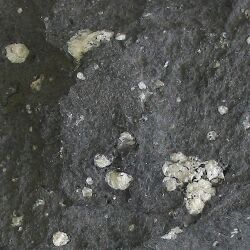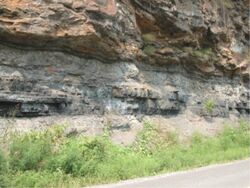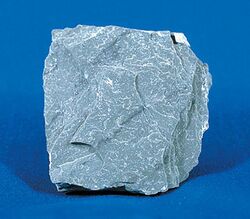Earth:List of rock types
From HandWiki
Short description: List of rock types recognized by geologists
The following is a list of rock types recognized by geologists. There is no agreed number of specific types of rock. Any unique combination of chemical composition, mineralogy, grain size, texture, or other distinguishing characteristics can describe a rock type. Additionally, different classification systems exist for each major type of rock.[1] There are three major types of rock: igneous rock, metamorphic rock, and sedimentary rock.
Igneous rocks
- Earth:Adakite – Volcanic rock type
- Earth:Andesite – Type of volcanic rock
- Earth:Anorthosite – Mafic intrusive igneous rock composed predominantly of plagioclase
- Earth:Basalt – A magnesium- and iron-rich extrusive igneous rock
- Chemistry:Mugearite – Volcanic rock type
- Earth:Shoshonite – Potassium-rich variety of basaltic trachyandesite
- Earth:Basanite – Type of volcanic rock
- Earth:Blairmorite – Rare porphyritic volcanic rock
- Earth:Boninite – Ultramafic extrusive rock high in both magnesium and silica
- Chemistry:Charnockite – Type of granite containing orthopyroxene
- Earth:Dacite – Volcanic rock intermediate in composition between andesite and rhyolite
- Earth:Diorite – Igneous rock type
- Earth:Dunite – Ultramafic and ultrabasic rock from Earth's mantle which is made of the mineral olivine
- Chemistry:Granite – Type of igneous rock
- Earth:Granodiorite – Type of coarse grained intrusive igneous rock
- Earth:Hyaloclastite – Volcaniclastic accumulation or breccia
- Earth:Icelandite – Igneous rock type
- Earth:Ignimbrite – Type of volcanic rock
- Earth:Kimberlite – Igneous rock which sometimes contains diamonds
- Earth:Komatiite – Magnesium-rich igneous rock
- Earth:Lamproite – Mantle rock expulsed to the surface in volcanic pipes
- Earth:Latite – Type of volcanic rock – A silica-undersaturated form of andesite
- Earth:Nephelinite – Igneous rock made up almost entirely of nepheline and clinopyroxene – A silica-undersaturated plutonic rock with >90% nepheline
- Chemistry:Obsidian – Naturally occurring volcanic glass
- Earth:Pegmatite – Igneous rock with very large interlocked crystals
- Earth:Phonolite – Uncommon extrusive rock – A silica-undersaturated volcanic rock; essentially similar to nepheline syenite
- Earth:Phonotephrite – A volcanic rock with a composition between phonolite and tephrite
- Porphyry – Textural form of igneous rock with large grained crystals in a fine matrix
- Earth:Pumice – Light colored highly vesicular volcanic rock
- Earth:Pyroxenite – Igneous rock - a coarse grained plutonic rock composed of >90% pyroxene
- Earth:Rhyodacite – Volcanic rock rich in silica and low in alkali metal oxides – A felsic volcanic rock which is intermediate between a rhyolite and a dacite
- Earth:Rhyolite – Igneous, volcanic rock, of felsic (silica-rich) composition
- Earth:Comendite – Hard, peralkaline igneous rock, a type of light blue grey rhyolite
- Earth:Pantellerite – Peralkaline rhyolite type of volcanic rock
- Earth:Scoria – Dark vesicular volcanic rock
- Earth:Sovite – A coarse-grained carbonatite rock
- Chemistry:Syenite – Intrusive igneous rock – A plutonic rock dominated by orthoclase feldspar; a type of granitoid
- Earth:Tephriphonolite – Type of igneous rock – A volcanic rock with a composition between phonotephrite and phonolite
- Earth:Tephrite – Igneous, volcanic rock – A silica-undersaturated volcanic rock
- Earth:Trachyandesite – Extrusive igneous rock – An alkaline intermediate volcanic rock
- Earth:Benmoreite – Volcanic rock type - sodic trachyandesite
- Earth:Trachybasalt – Volcanic rock – A volcanic rock with a composition between basalt and trachyte
- Chemistry:Hawaiite – Volcanic rock – a sodic type of trachybasalt, typically formed by ocean island (hot spot) volcanism
- Earth:Trachyte – Extrusive igneous rock – A silica-undersaturated volcanic rock; essentially a feldspathoid-bearing rhyolite
- Earth:Tuff – Rock consolidated from volcanic ash
Sedimentary rocks
- Earth:Argillite – Sedimentary rock, mostly of indurated clay particles
- Earth:Arkose – Type of sandstone containing at least 25% feldspar
- Earth:Banded iron formation – Distinctive layered units of iron-rich sedimentary rock that are almost always of Precambrian age
- Earth:Calcarenite – A type of limestone that is composed predominantly of sand-size grains
- Earth:Chalk – A soft, white, porous sedimentary rock made of calcium carbonate
- Earth:Chert – Hard, fine-grained sedimentary rock composed of cryptocrystalline silica
- Earth:Coal – Combustible sedimentary rock composed primarily of carbon
- Conglomerate – Sedimentary rock composed of smaller rock fragments
- Earth:Coquina – A sedimentary rock that is composed mostly of fragments of shells
- Earth:Diamictite – Type of sedimentary rock
- Earth:Dolomite (rock), also known as Dolostone – Sedimentary carbonate rock that contains a high percentage of the mineral dolomite
- Earth:Evaporite – Water-soluble mineral deposit formed by evaporation from an aqueous solution
- Earth:Flint – Cryptocrystalline form of the mineral quartz
- Earth:Geyserite – Form of opaline silica often found around hot springs and geysers
- Earth:Greywacke – Sandstone with angular grains in a clay-fine matrix
- Earth:Gritstone – Hard, coarse-grained, siliceous sandstone
- Earth:Itacolumite – Porous sandstone known for flexibility
- Earth:Jaspillite – Banded mixture of hematite and quartz
- Earth:Laterite – Product of rock weathering in wet tropical climate rich in iron and aluminium
- Chemistry:Lignite – Soft, brown, combustible, sedimentary rock
- Earth:Limestone – Sedimentary rocks made of calcium carbonate
- Earth:Marl – Lime-rich mud or mudstone which contains variable amounts of clays and silt
- Earth:Oil shale – Organic-rich fine-grained sedimentary rock containing kerogen
- Earth:Oolite – Sedimentary rock formed from ooids
- Earth:Phosphorite – Sedimentary rock containing large amounts of phosphate minerals – A non-detrital sedimentary rock that contains high amounts of phosphate minerals
- Earth:Sandstone
- Chemistry:Shale – Fine-grained, clastic sedimentary rock
- Earth:Siltstone – Sedimentary rock which has a grain size in the silt range
- Earth:Sylvinite – A sedimentary rock made of a mechanical mixture of sylvite and halite
- Earth:Travertine – A form of limestone deposited by mineral springs
- Earth:Tufa – Porous limestone rock formed when carbonate minerals precipitate out of ambient temperature water
- Earth:Turbidite – Geologic deposit of a turbidity current
Metamorphic rocks

Banded gneiss with a dike of granite orthogneiss
- Chemistry:Anthracite – Hard, compact variety of coal
- Earth:Amphibolite – Metamorphic rock type
- Earth:Blueschist – Type of metavolcanic rock
- Earth:Cataclasite – Rock found at geological faults – A rock formed by faulting
- Earth:Eclogite – A dense metamorphic rock formed under high pressure
- Earth:Gneiss – Common high-grade metamorphic rock
- Earth:Granulite – Class of high-grade medium to coarse grained metamorphic rocks
- Earth:Greenschist – Metamorphic rock – A mafic metamorphic rock dominated by green amphiboles
- Chemistry:Hornfels
- Chemistry:Calcflinta – A type of hornfels found in the Scottish Highlands
- Chemistry:Marble – a metamorphosed limestone
- Earth:Migmatite – Mixture of metamorphic rock and igneous rock
- Earth:Mylonite – Metamorphic rock – A metamorphic rock formed by shearing
- Metapsammite – A metamorphic rock with a protolith of quartz-rich (sandstone) sedimentary rock
- Chemistry:Phyllite – Type of foliated metamorphic rock – A low grade metamorphic rock composed mostly of micaceous minerals
- Astronomy:Pseudotachylite – A glass formed by melting within a fault via friction
- Earth:Quartzite – Hard, non-foliated metamorphic rock – A metamorphosed sandstone typically composed of >95% quartz
- Chemistry:Schist – Easily split medium-grained metamorphic rock
- Earth:Serpentinite – Rock formed by hydration and metamorphic transformation of olivine
- Chemistry:Skarn – Hard, coarse-grained, hydrothermally altered metamorphic rocks
- Chemistry:Slate – Metamorphic rock - A low grade metamorphic rock formed from shale or silts
- Chemistry:Suevite – Rock consisting partly of melted material formed during an impact event – A rock formed by partial melting during a meteorite impact
- Earth:Talc carbonate – A metamorphosed ultramafic rock with talc as an essential constituent; similar to a serpentinite
- Earth:Soapstone – Talc-bearing metamorphic rock – Essentially a talc schist
- Earth:Tectonite – Rock type – A rock whose fabric reflects the history of its deformation
- Earth:Whiteschist – A high pressure metamorphic rock containing talc and kyanite
Specific varieties
The following are terms for rocks that are not petrographically or genetically distinct but are defined according to various other criteria; most are specific classes of other rocks, or altered versions of existing rocks. Some archaic and vernacular terms for rocks are also included.
- Earth:Appinite – Type of igneous rock – A group of varieties of lamprophyre, mostly rich in hornblende
- Earth:Aphanite – Igneous rock composed of very small crystals invisible to the naked eye
- Chemistry:Epidosite – Hydrothermally altered epidote- and quartz-bearing rock
- Earth:Felsite – Very fine-grained volcanic rock that sometimes contains larger crystals
- Earth:Flint – Cryptocrystalline form of the mineral quartz
- Earth:Ganister – Hard, fine-grained quartzose sandstone, or orthoquartzite
- Earth:Gossan – Intensely oxidized, weathered or decomposed rock
- Earth:Hyaloclastite – Volcaniclastic accumulation or breccia
- Chemistry:Jadeitite – Metamorphic rock found in blueschist-grade metamorphic terranes
- Earth:Jasperoid – A hematite-silica metasomatite analogous to a skarn
- Earth:Kenyte – Type of igneous rock - A variety of phonolite, first found on Mount Kenya
- Chemistry:Lapis lazuli – Metamorphic rock containing lazurite, prized for its intense blue color - A rock composed of lazurite and other minerals
- Minette – A variety of lamprophyre
- Earth:Novaculite – Type of rock – A type of chert found in Oklahoma, Arkansas, and Texas
- Chemistry:Pietersite – Commercial term for a variety of chalcedony
- Pyrolite – A chemical analogue considered to theoretically represent the Earth's upper mantle
- Earth:Rapakivi granite – Type of igneous rock
- Chemistry:Rodingite – A mafic rock metasomatized by serpentinization fluids
- Earth:Taconite – Variety of iron-bearing sedimentary rock
- Chemistry:Unakite – An altered granite
- Chemistry:Wad – Porous secondary manganese oxyhydroxide – A rock rich in manganese oxide or manganese hydroxide
See also
- Earth:List of minerals
- Astronomy:List of rocks on Mars – Alphabetical list of named rocks and meteorites found on Mars
- Earth:Rock cycle – Transitional concept of geologic time
- Earth:List of rock formations: for a list of unusual or culturally significant rock outcrops
- Earth:Leaverite – Rock in the field that looks interesting but is actually not
References
External links
- British Geological Survey rock classification scheme
- Igneous rock classification
- Rock Types Article by Encyclopædia Britannica
- Classification of common rocks and soils
- Metamorphic Rock Classification
- Volcanic rocks
- Earth Science Education Unit virtual rock kit
 |











